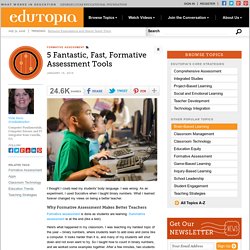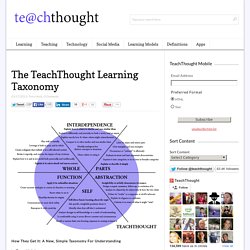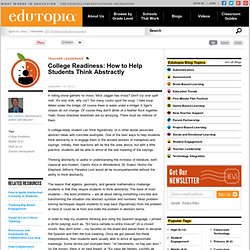

Collaboration Resources - Google Docs. Edutopia. I thought I could read my students' body language.

I was wrong. As an experiment, I used Socrative when I taught binary numbers. What I learned forever changed my views on being a better teacher. Why Formative Assessment Makes Better Teachers Formative assessment is done as students are learning. Here's what happened in my classroom. "We've got this, it's easy," they said. I looked at the other students and asked, "Do you have this? " They nodded their heads furiously up and down in a "yes. " My teacher instincts said that everyone knew it, but I decided to experiment. I was floored. I taught for another few minutes and gave them another problem. But the end result was not what you think. I am sold. Good teachers in every subject will adjust their teaching based upon what students know at each point.
Formative Assessment Toolkit Learn the strengths and weaknesses of each tool. 1. Socrative can be used for quick quizzes and also on the fly, as I've already shared. Kevinhoneycutt.org. Dynamic Learning & Meaning Making, Conference Strands & Presenter Abstracts, 2012 Conference, islPAL Conference, islPAL International Society on Leadership in Pedagogies and Learning. Dynamic Learning & Meaning Making Art Costa - Workshop Title: Assessing the Quality of Your Classroom Questions. Teachers ask a lot of questions. This workshop will help us become aware of the questions we are asking and to compose questions deliberately intended to engage and transform the thinking of others. As a result, you will be able to monitor your own and eliminate "unproductive" questions and more skillfully compose questions that include positive presuppositions and that invite complex cognition.
Denis Goodrum - Workshop Inquiry-based Teaching The Australian Science curriculum encourages an inquiry-based teaching approach. Kathryn Glasswell - Keynote Navigating Thinking: Innovations in Teaching and Learning for Higher Order Thinking in Reading Comprehension The ability to strategically, critically and creatively solve problems is key to success in our changing world. Tim Gauntley: Resourceful Curriculum for 21st Century Learning. Evaluating Non-Fiction Resources: Criteria for Quality. Evaluating Non-Fiction Resources: Criteria for Quality. Media Fluency. Solution Fluency. The Best Resources On Students Using Gestures & Physical Movement To Help With Learning.
I’m a big fan of encouraging students to accompany learning with gestures and physical movement, particularly, though not exclusively, with English Language Learners.

I thought I’d begin a short “The Best…” list on the topic, and ask readers to contribute additions. Here are my choices for The Best Resources On Students Using Gestures & Physical Movement To Help With Learning: Total Physical Response (TPR) is a mainstay of many ESL/EFL instructors. Teacher Joe has a nice short description of it, and here’s a much more TPR guide from the English Language and Literacy Center. Here’s a study on how gestures improve memory. What’s a quick and easy way to improve learning? Brief training with co-speech gesture lends a hand to word learning in a foreign language is yet another study.
How They Get It: A New, Simple Taxonomy For Understanding. How They Get It: A New, Simple Taxonomy For Understanding by Terry Heick How can you tell if a student really understands something?

They learn early on to fake understanding exceptionally well, and even the best assessment leaves something on the table. (In truth, a big portion of the time students simply don’t know what they don’t know.) The idea of understanding is, of course, at the heart of all learning, and solving it as a puzzle is one of the three pillars of formal learning environments and education. - 20+ Apps to Support the Digital Storytelling Process.
Student Materials: Comic Creator. Index to Group Activities, Games, Exercises & Initiatives. College Readiness: How to Help Students Think Abstractly. A rolling stone gathers no moss.

Mick Jagger has moss? Don't cry over spilt milk. It's only milk, why cry? Too many cooks spoil the soup. I hate soup. A college-ready student can think figuratively, or in other words associate abstract ideas with concrete examples. Thinking abstractly is useful in understanding the richness of literature, both classical and modern.
The reason that algebra, geometry, and general mathematics challenge students is that they require students to think abstractly. In order to help my students thinking and using the Spanish language, I printed a dicho (saying) such as, "En boca cerrada no entra mosca! " It was always illuminating and inspiring to watch as students caught the joke, or the meaning of a passage of literature. How do you get your students to think abstractly?